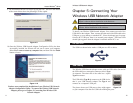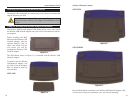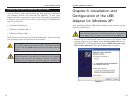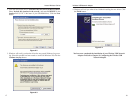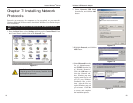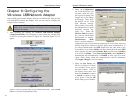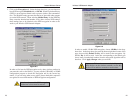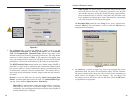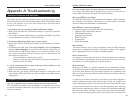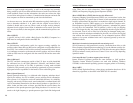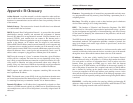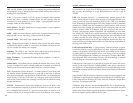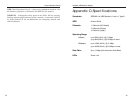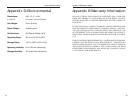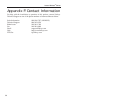
er is provided with a copy of the TCP/IP program just as every other computer
that you may send messages to or get information from also has a copy of
TCP/IP.
UDP (User Datagram Protocol) - A communications method (protocol) that
offers a limited amount of service when messages are exchanged between com-
puters in a network that uses the Internet Protocol (IP). UDP is an alternative
to the Transmission Control Protocol (TCP) and, together with IP, is sometimes
referred to as UDP/IP. Like the Transmission Control Protocol, UDP uses the
Internet Protocol to actually get a data unit (called a datagram) from one com-
puter to another. Unlike TCP, however, UDP does not provide the service of
dividing a message into packets (datagrams) and reassembling it at the other
end. Specifically, UDP doesn’t provide sequencing of the packets that the data
arrives in. This means that the application program that uses UDP must be able
to make sure that the entire message has arrived and is in the right order.
Network applications that want to save processing time because they have very
small data units to exchange (and therefore very little message reassembling to
do) may prefer UDP to TCP.
USB (Universal Serial Bus) - A “plug-and-play” interface between a comput-
er and add-on devices (such as audio players, joysticks, keyboards, telephones,
scanners, and printers). With USB, a new device can be added to your comput-
er without having to add an adapter card or even having to turn the computer
off. The USB peripheral bus standard was developed by Compaq, IBM, DEC,
Intel, Microsoft, NEC, and Northern Telecom; and the technology is available
without charge for all computer and device vendors.
USB supports a data speed of 12 megabit per second. This speed will accom-
modate a wide range of devices, including MPEG video devices, data gloves,
and digitizers. It is anticipated that USB will easily accommodate plug-in tele-
phones that use Integrated Services Digital Network and digital private branch
exchange.
Since October 1996, the Windows operating systems have been equipped with
USB driver or special software designed to work with specific I/O device types.
USB is integrated into Windows 98. Today, most new computers and peripher-
al devices are equipped with USB.
A different “plug-and-play” standard, FireWire/IEEE 1394, is designed to sup-
port much higher data rates and devices such as video camcorders and DVD
(digital video disk or digital versatile disk) players. Both standards are expect-
ed to exist together, serving different device types.
34
Wireless USB Network Adapter
Instant Wireless
TM
Series
ISP - An ISP (Internet service provider) is a company that provides individuals
and companies access to the Internet and other related services such as Web site
building and virtual hosting.
LAN - A local area network (LAN) is a group of computers and associated
devices that share a common communications line and typically share the
resources of a single processor or server within a small geographic area (for
example, within an office building).
MAC Address - The MAC (Media Access Control) address is your computer’s
unique hardware number.
mIRC - mIRC runs under Windows and provides a graphical interface for log-
ging onto IRC servers and listing, joining and leaving channels.
Network Mask - also known as the “Subnet Mask.”
Ping - (Packet INternet Groper) An Internet utility used to determine whether
a particular IP address is online. It is used to test and debug a network by send-
ing out a packet and waiting for a response.
Roaming - The ability to use a wireless device and be able to move from one
access point’s range to another without losing the connection.
Static IP Address - A permanent IP address that is assigned to a node in a
TCP/IP network.
Subnet Mask - The method used for splitting IP networks into a series of sub-
groups, or subnets. The mask is a binary pattern that is matched up with the IP
address to turn part of the host ID address field into a field for subnets.
TCP (Transmission Control Protocol) - A method (protocol) used along with
the Internet Protocol (Internet Protocol) to send data in the form of message
units between computers over the Internet. While IP takes care of handling the
actual delivery of the data, TCP takes care of keeping track of the individual
units of data (called packet) that a message is divided into for efficient routing
through the Internet.
TCP/IP - Transmission Control Protocol/Internet Protocol (TCP/IP) is the
basic communication language or protocol of the Internet. It can also be used
as a communications protocol in a private network (either an intranet or an
extranet). When you are set up with direct access to the Internet, your comput-
33



